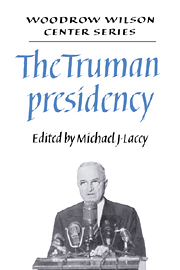Book contents
- Frontmatter
- Contents
- Acknowledgments
- Introduction and summary: The Truman era in retrospect
- 1 The mind and character of Harry S. Truman
- Part I Domestic politics and issues
- Part II Foreign policy and national defense
- 7 The national security state reconsidered: Truman and economic containment, 1945–1950
- 8 The insecurities of victory: the United States and the perception of the Soviet threat after World War II
- 9 Alliance and autonomy: European identity and U.S. foreign policy objectives in the Truman years
- 10 U.S. policy in the Near East: the triumphs and tribulations of the Truman administration
- 11 Toward a post-colonial order: Truman administration policies toward South and Southeast Asia
- 12 Occupied Japan and the cold war in Asia
- 13 The Truman administration and the Korean War
- About the authors
- Index
10 - U.S. policy in the Near East: the triumphs and tribulations of the Truman administration
Published online by Cambridge University Press: 06 October 2009
- Frontmatter
- Contents
- Acknowledgments
- Introduction and summary: The Truman era in retrospect
- 1 The mind and character of Harry S. Truman
- Part I Domestic politics and issues
- Part II Foreign policy and national defense
- 7 The national security state reconsidered: Truman and economic containment, 1945–1950
- 8 The insecurities of victory: the United States and the perception of the Soviet threat after World War II
- 9 Alliance and autonomy: European identity and U.S. foreign policy objectives in the Truman years
- 10 U.S. policy in the Near East: the triumphs and tribulations of the Truman administration
- 11 Toward a post-colonial order: Truman administration policies toward South and Southeast Asia
- 12 Occupied Japan and the cold war in Asia
- 13 The Truman administration and the Korean War
- About the authors
- Index
Summary
U.S. policy in the Near East during the Truman administration was concerned primarily with the region's “Northern Tier” (Iran, Turkey, and Greece) and Palestine. Events in these two areas provided the context for several major policy decisions—the Truman Doctrine and U.S. support for the creation and establishment of Israel—that were among the best known and most controversial of the Truman years. In this essay I take a close look at these decisions, examine major questions that have been raised about the Truman administration's policies, and, in light of recent scholarship, attempt to assess them. Before such an assessment can be made, however, it is necessary to examine the geopolitical context within which the Truman administration was forced to operate.
When President Truman took office, World War II was not yet over but it already had radically altered the world power balance and shifted the loci of world power to Washington and Moscow. Within a year Stalin was exploring his options along the Soviet Union's southern borders and, it appeared, would continue to do so unless resisted. The British Empire, meanwhile, was disintegrating. By 1948, the British would be forced to withdraw their forces from Greece, Turkey, India, and Palestine. The combination of the rise of Soviet power and the demise of British influence presented the United States with new responsibilities and difficult choices.
In the nineteenth century the expanding Russian and British empires had played for high stakes.
- Type
- Chapter
- Information
- The Truman Presidency , pp. 299 - 338Publisher: Cambridge University PressPrint publication year: 1989
- 2
- Cited by



